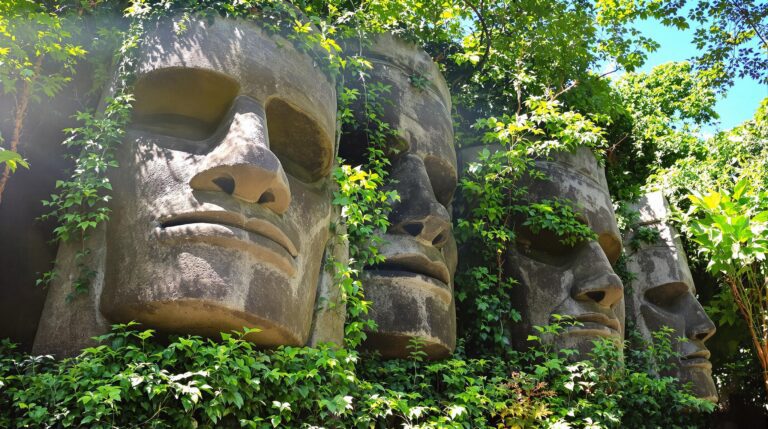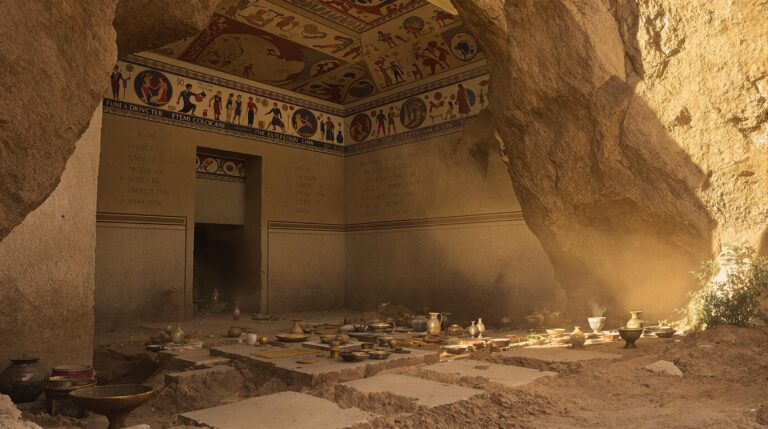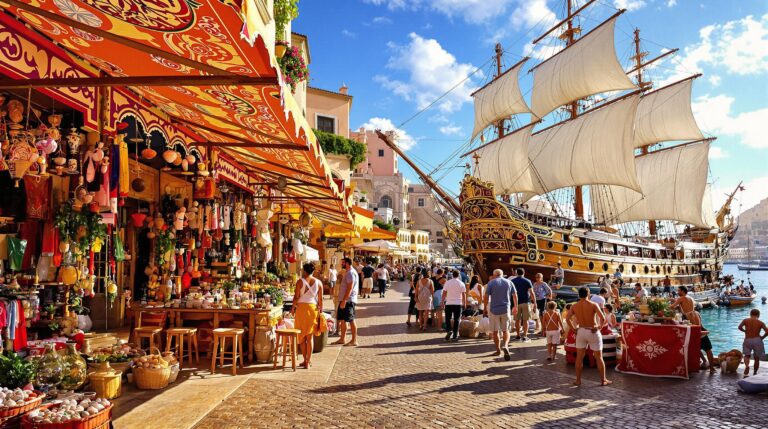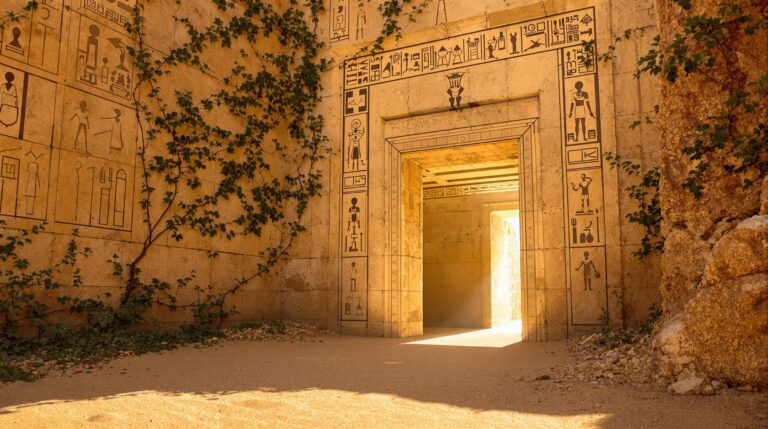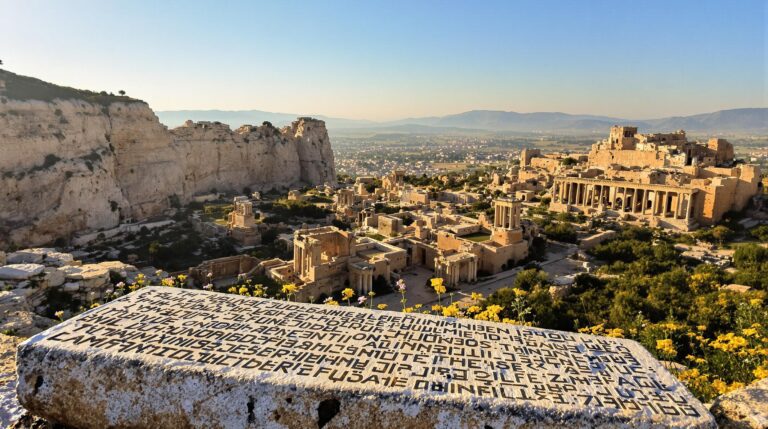Harappan Civilization: Inside the Planned Cities of the Indus Valley

The Harappan Civilization presents a fascinating study of urban sophistication in the ancient world.
Its planned cities, characterized by grid layouts and advanced drainage systems, reveal a high level of organization.
Intriguingly, the relationship between architecture and social structure raises questions about governance and public health.
What insights can be gleaned from the remnants of these urban centers, and how did they influence subsequent civilizations in the region?
Key Takeaways
Hide- Harappan cities featured grid layouts with right-angle street patterns, facilitating efficient movement and trade among residents.
- Advanced drainage and sanitation systems underscored the civilization's commitment to hygiene and urban functionality.
- The Great Bath at Mohenjo-Daro exemplified sophisticated engineering and communal health initiatives within urban planning.
- Civic structures, including granaries and assembly halls, indicated centralized governance and community decision-making practices.
- The intricate Indus Script and cultural artifacts reflect the society's religious practices and values, revealing insights into their daily lives.
Introduction to the Harappan Civilization
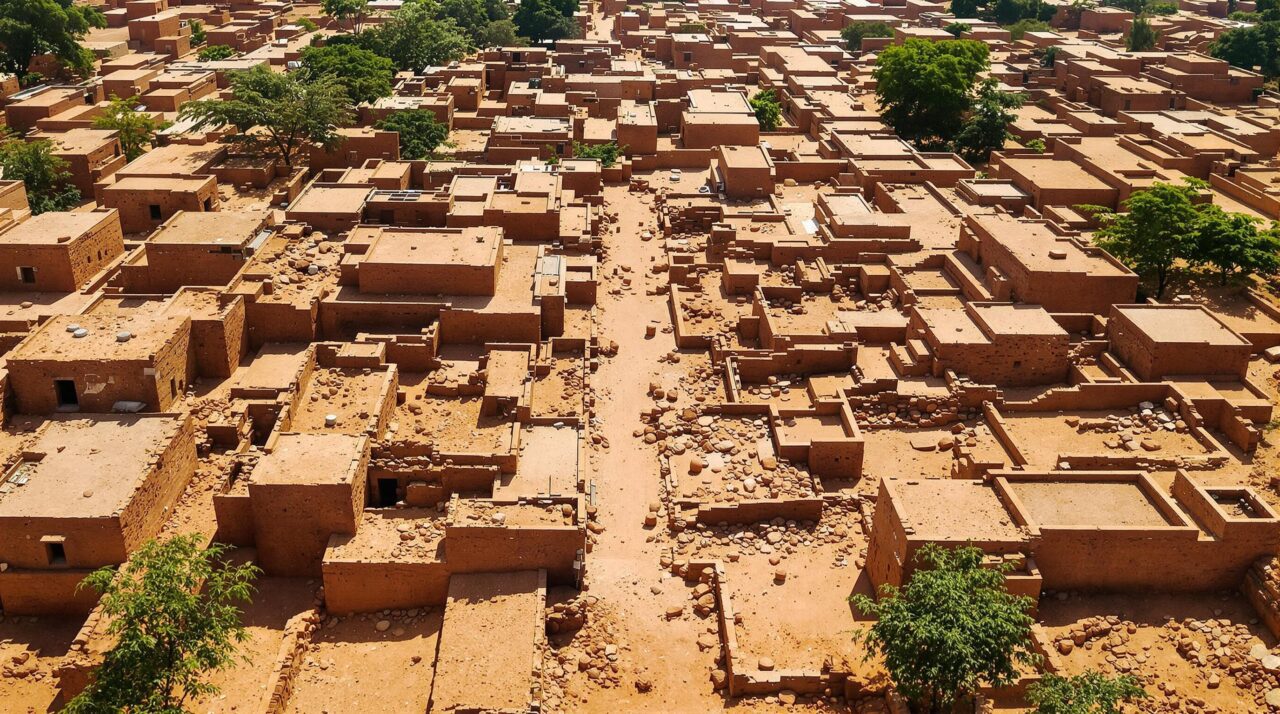
The Harappan Civilization, flourishing along the fertile banks of the Indus River Valley, presents a fascinating case study of early urban development.
Scholars are intrigued by its origins, which remain a subject of ongoing research, as well as the distinct phases that marked its evolution over time.
Analyzing the timeline and significant milestones of this ancient society reveals much about its innovative infrastructure and social organization.
Origins Along the Indus River Valley
The origins of the Harappan Civilization are intricately linked to the fertile expanse of the Indus River Valley, which spans present-day Pakistan and parts of India.
This geographical setting offered a conducive environment for early settlements, fostering agricultural development and trade.
Analyzing the interplay between the river’s resources and the growth of these communities raises questions about how natural factors shaped their societal structures and cultural evolution.
Geographic Scope Across Modern-Day Pakistan and India
Emerging from the fertile banks of the Indus River Valley, the Harappan Civilization sprawled across a vast geographic area that now encompasses parts of modern-day Pakistan and northwest India.
This extensive region, characterized by diverse landscapes, invites curiosity about its influence on urban planning and trade networks.
How did this geographic breadth shape social structures and cultural exchanges within this ancient society?
Environmental Factors Supporting Early Settlements
While the fertile landscape of the Indus River Valley provided an essential foundation for early settlements, a variety of environmental factors played a significant role in the rise of the Harappan Civilization.
Abundant water from the river supported agriculture, while seasonal monsoons guaranteed crop diversity.
Additionally, natural resources such as clay and minerals facilitated the development of sophisticated urban infrastructure, enhancing societal complexity.
Timeline and Major Phases of Development
The timeline of the Harappan Civilization reveals a fascinating evolution from early settlements and agricultural practices to a sophisticated urban society.
This progression raises questions about the factors that influenced such significant changes in social organization and infrastructure.
Early Harappan Settlements and Agricultural Beginnings
Early Harappan settlements represent a fascinating chapter in the development of one of the world’s earliest urban civilizations.
These communities laid the groundwork for future advancements through:
- Agricultural Innovations: The adoption of farming techniques that supported population growth.
- Trade Networks: Early exchanges that connected diverse groups.
- Craft Specialization: Development of unique artisan skills, fostering economic diversity.
These elements were pivotal in shaping societal structures and cultural practices.
Mature Harappan Urban Expansion
As urbanization accelerated, the Mature Harappan phase emerged as a remarkable period within the Harappan Civilization, characterized by significant advancements in city planning, architectural sophistication, and social organization.
This era witnessed the construction of well-structured streets, advanced drainage systems, and standardized baked bricks.
How did these innovations facilitate trade and community cohesion? Such inquiries invite deeper exploration into the complexities of this extraordinary civilization.
Urban Planning and Infrastructure
The urban planning of the Harappan Civilization showcases a remarkable understanding of organization and efficiency, evident in its grid layouts and structured streets.
The presence of advanced drainage and sanitation systems highlights the society’s commitment to hygiene and urban functionality, while monumental structures like the Great Bath underscore their sophisticated water management practices.
What implications might these innovations have had on daily life and social structure within Harappan cities?
Grid Layouts and Organized Streets
The Harappan civilization exhibits a remarkable commitment to urban planning through its right-angle street layouts, which suggest a sophisticated understanding of spatial organization.
This grid pattern not only facilitated efficient movement but also delineated distinct residential blocks and public spaces, illustrating a deliberate approach to city divisions.
How did such structured infrastructure contribute to the overall functioning and social dynamics of these ancient urban centers?
Right-Angle Street Planning Across Cities
While examining the urban planning of the Harappan civilization, one cannot help but be intrigued by the meticulous right-angle street layouts that defined its cities.
This structured design facilitated:
- Efficient movement and trade.
- Enhanced accessibility to essential services.
- Aesthetic uniformity, fostering a sense of community.
Such deliberate organization reveals a sophisticated understanding of urban infrastructure, emphasizing the civilization’s innovative spirit and commitment to harmonious living.
Residential Blocks, Public Spaces, and City Divisions
Building upon the structured street layouts, the Harappan civilization showcased an impressive arrangement of residential blocks, public spaces, and city divisions that further exemplified their urban planning prowess.
Each residential area, meticulously organized, suggested a communal lifestyle, while public spaces likely served as hubs for social interaction.
This thoughtful division of space prompts inquiry into the societal values and daily lives of Harappan inhabitants.
Advanced Drainage and Sanitation Systems
The Harappan Civilization showcased remarkable ingenuity in urban sanitation, evident in the sophisticated covered drainage systems that lined their streets.
These engineering feats not only facilitated efficient waste management but also reflected a deep understanding of public health and urban planning.
Additionally, the presence of individual household waste disposal systems suggests a commitment to maintaining hygiene and order within the community.
Covered Drains Running Along Streets
Remarkably advanced for their time, the covered drains running along the streets of the Harappan Civilization exemplify a sophisticated approach to urban planning and sanitation.
These systems reveal essential insights about their society:
- Efficient Waste Management: Promoted hygiene and reduced health risks.
- Urban Design: Integrated into the city layout for ideal functionality.
- Cultural Values: Reflected a commitment to public health and welfare.
Individual Household Waste Disposal Systems
While the sophisticated covered drains of the Harappan Civilization showcased a communal approach to sanitation, individual household waste disposal systems further illustrate the civilization’s advanced urban planning.
Each home featured private latrines connected to the drainage network, highlighting a remarkable understanding of hygiene. This integration of personal and communal sanitation reflects a society valuing both individual responsibility and collective health, promoting a cleaner urban environment.
Great Bath and Water Management Structures
The Great Bath at Mohenjo-Daro serves as a remarkable example of Harappan engineering, illustrating the civilization’s sophisticated approach to public water management.
Its design, alongside the network of wells and water storage tanks, raises questions about the societal values placed on communal hygiene and ritualistic practices.
How did these structures reflect the urban planning priorities of the time, and what implications did they have for daily life in this ancient civilization?
Design and Construction of the Great Bath at Mohenjo-Daro
An impressive feature of the Harappan civilization is the Great Bath at Mohenjo-Daro, which exemplifies advanced urban planning and water management techniques of its time.
This monumental structure showcases:
- Sophisticated waterproofing methods using bitumen.
- Symmetrical design promoting communal use.
- Innovative drainage systems ensuring effective water management.
Such elements reflect the civilization’s commitment to hygiene and social cohesion, inviting further exploration into their engineering prowess.
Wells, Water Storage Tanks, and Their Public Use
Wells and water storage tanks played an essential role in the urban infrastructure of the Harappan civilization, reflecting their sophisticated understanding of hydrology and communal needs.
These structures demonstrate an impressive focus on public health and accessibility, providing crucial resources for daily life.
The strategic placement of wells and tanks suggests a deep awareness of collaborative living and the importance of shared resources in thriving communities.
Architecture and Public Buildings
The architecture of the Harappan civilization reveals a sophisticated understanding of urban design, reflecting both functional and aesthetic considerations.
With a variety of residential housing styles and materials, alongside the presence of granaries, assembly halls, and civic buildings, these structures serve not only as living spaces but also as centers for community interaction and governance.
What do these architectural choices indicate about the social structure and priorities of the Harappan people?
Residential Housing Styles and Materials
The architectural styles of the Harappan civilization reveal a sophisticated understanding of urban planning and material use, particularly through the extensive use of baked bricks.
Courtyard-centered designs suggest a focus on communal living and natural light, while multi-room homes equipped with advanced drainage systems highlight an innovative approach to sanitation.
What do these features indicate about the social structure and priorities of the Harappan people?
Use of Baked Bricks and Courtyard-Centered Designs
Baked bricks, a hallmark of Harappan architecture, reveal much about the ingenuity and sophistication of this ancient civilization.
Their use in courtyard-centered designs suggests a deliberate approach to urban planning, emphasizing:
- Community Interaction: Courtyards served as communal spaces.
- Natural Ventilation: Design facilitated airflow and light.
- Structural Integrity: Baked bricks guaranteed durability against weather.
These elements reflect a thoughtful integration of functionality and aesthetics.
Multi-Room Homes With Access to Drainage
Multi-room homes in the Harappan Civilization showcase an advanced understanding of residential architecture, reflecting both social structure and environmental adaptation.
These dwellings often featured separate living spaces, enhancing privacy and utility. Ingeniously designed drainage systems provided essential sanitation, revealing a commitment to public health.
Such innovative features prompt inquiries into the daily lives of Harappans and their sophisticated approaches to urban planning and community well-being.
Granaries, Assembly Halls, and Civic Buildings
The architectural design of granaries, assembly halls, and civic buildings in the Harappan Civilization reveals intriguing insights into their societal structure.
The layouts suggest a system of centralized storage and governance, potentially indicating a sophisticated level of administration and resource management.
Additionally, the large pillared halls may have served multiple functions, from communal gatherings to administrative meetings, raising questions about their role in fostering civic life.
Layouts Suggesting Centralized Storage and Governance
Evidence from the Harappan civilization reveals a sophisticated approach to urban planning that suggests a system of centralized storage and governance.
This can be observed in:
- Granaries positioned centrally, indicating food security management.
- Assembly halls designed for communal decision-making.
- Civic buildings reflecting organized administrative functions.
Such layouts provoke questions about the societal structure and the extent of centralized authority in these ancient cities.
Potential Functions of Large Pillared Halls
While the precise functions of large pillared halls in the Harappan civilization remain a topic of scholarly debate, their architectural grandeur and strategic placement suggest they served multiple key roles within the urban landscape.
These structures may have functioned as assembly halls for civic gatherings, sites for ritualistic activities, or storage facilities, reflecting the complex social dynamics and communal organization of this ancient society.
Craftsmanship, Trade, and Economy
The craftsmanship of the Harappan civilization reflects a high level of skill among artisans, showcasing intricate techniques in material production.
This expertise not only contributed to the creation of diverse goods but also facilitated the establishment of extensive trade networks and commercial centers.
How did these economic interactions influence the social structure and cultural exchanges within this ancient society?
Skilled Artisans and Material Production
The Harappan civilization showcased remarkable craftsmanship, particularly in pottery, bead-making, and metallurgical work.
Skilled artisans employed materials such as steatite, carnelian, and copper, raising questions about the techniques and trade networks that facilitated these intricate productions.
How did these artisanal practices influence economic structures and social hierarchies within this ancient society?
Pottery, Bead-Making, and Metallurgical Work
Artistry in the Harappan Civilization reveals a sophisticated understanding of materials, particularly through pottery, bead-making, and metallurgical work.
This craftsmanship suggests a complex economy and trade network characterized by:
- Intricate pottery designs showcasing innovative techniques.
- Diverse beads crafted from various materials, indicating cultural significance.
- Advanced metalworking that reflects technological prowess.
Such skills not only highlight artistic expression but also economic importance.
Use of Steatite, Carnelian, and Copper in Crafting
Craftsmanship in the Harappan Civilization prominently featured the use of steatite, carnelian, and copper, each material selected for its unique properties and potential applications.
Steatite, prized for its softness, allowed intricate carvings, while carnelian, with its striking hues, was favored for beads and seals.
Copper’s malleability enabled innovative tools and ornaments, facilitating trade and enhancing the economy through skilled artisanal production.
Trade Networks and Commercial Centers
The Harappan Civilization exhibited remarkable trade networks that extended to both Mesopotamia and Central Asia, suggesting a sophisticated economy driven by long-distance exchanges.
The use of standardized weights, measures, and seals points to an organized system that facilitated commerce and guaranteed uniformity in transactions.
How did these practices contribute to the economic stability and cultural interactions within and beyond the Harappan society?
Long-Distance Trade with Mesopotamia and Central Asia
While the Harappan civilization is often celebrated for its advanced urban planning and architectural achievements, its long-distance trade with Mesopotamia and Central Asia reveals a complex economic network that greatly contributed to its prosperity.
Key elements of this trade included:
- Export of luxury goods like beads and textiles
- Import of metals and precious stones
- Cultural exchanges influencing craftsmanship and technology
Standardized Weights, Measures, and Seals
Standardized weights, measures, and seals played a pivotal role in the Harappan civilization’s economic framework, facilitating trade and enhancing commercial interactions.
These artifacts, often made from materials like steatite, guaranteed uniformity and trust in transactions. Their intricate designs and inscriptions suggest a sophisticated understanding of commerce, which likely bolstered both local and regional economies, highlighting the civilization’s advanced organizational capabilities.
Writing, Symbolism, and Cultural Insights
The Indus Script remains one of the most enigmatic features of the Harappan Civilization, characterized by its intricate symbols that have yet to be fully deciphered.
This script, alongside various cultural artifacts, offers tantalizing clues about the religious practices and societal values of the time.
Analyzing these elements raises intriguing questions about the connections between writing, symbolism, and the broader cultural framework of this ancient society.
Indus Script and Its Mysterious Symbols
The Indus Script presents a fascinating enigma, characterized by its recurring symbols found on seals and tablets.
Researchers speculate on the potential language and communication functions these inscriptions may have served within Harappan society.
Analyzing these symbols offers insights into the cultural and administrative complexities of this ancient civilization.
Common Inscriptions on Seals and Tablets
Seals and tablets from the Harappan Civilization serve as intriguing artifacts that encapsulate the complexity of their writing system, known as the Indus script.
Common inscriptions reveal:
- Symbolic motifs, reflecting social status or trade affiliations.
- Repeated characters, suggesting a standardized form of communication.
- Unique animal depictions, hinting at cultural significance and beliefs.
These elements invite deeper exploration into the civilization’s rich narrative.
Theories on Language and Communication Purposes
Exploring the inscriptions found on seals and tablets reveals a multifaceted approach to communication within the Harappan Civilization.
Scholars theorize that the Indus script served various purposes, from administrative record-keeping to ritualistic expression.
The enigmatic symbols suggest a complex society rich in cultural insights, yet the lack of decipherable text leaves questions lingering about their true meanings and communicative intent.
Religious Practices and Cultural Artifacts
The religious practices of the Harappan Civilization reveal a complex interplay between cultural artifacts and spiritual beliefs.
Figurines and amulets suggest a diverse array of symbolic meaning, while the presence of ritual bathing sites and fire altars indicates a structured approach to worship.
Analyzing these elements raises intriguing questions about the significance of sacred animals and the overall spiritual framework of this ancient society.
Figurines, Amulets, and Ritual Bathing Sites
While examining the artifacts of the Harappan Civilization, one uncovers a lively mosaic of cultural expressions through figurines, amulets, and ritual bathing sites.
These elements reveal significant insights into their society:
- Figurines – Often depicting deities or animals, suggesting spiritual beliefs.
- Amulets – Used for protection, reflecting personal and communal values.
- Ritual Bathing Sites – Indicating the importance of purification in daily life.
The Role of Fire Altars and Sacred Animals
Although often overlooked, fire altars and the presence of sacred animals within the Harappan Civilization offer profound insights into their spiritual and cultural frameworks.
These altars, meticulously constructed, suggest ritual significance, while depictions of animals hint at symbolic representations of deities or ancestors.
Such elements reveal a complex belief system, reflecting a society deeply intertwined with nature and the divine, fostering a unique cultural identity.
Major Urban Centers and Their Features
The major urban centers of the Harappan Civilization, such as Mohenjo-Daro and Harappa, exhibit remarkable urban planning and architectural sophistication that invite closer examination.
Each one of the lost cities, from the meticulously designed streets of Mohenjo-Daro to the cultural significance of Harappa, reflects a unique aspect of Harappan life, while Dholavira and Lothal illustrate the varied adaptations to coastal and inland environments.
Together, these centers provide critical insights into the social, economic, and cultural dynamics of this ancient civilization.
Mohenjo-Daro: A Model of Urban Sophistication
Mohenjo-Daro stands as a remarkable example of urban planning and architectural sophistication within the Harappan Civilization.
Its Citadel Complex, elaborate bathing facilities, and extensive granaries reflect advanced engineering and social organization, while the layout of residential districts and central streets reveals a thoughtful approach to community living.
What can these features tell us about the daily lives and priorities of its inhabitants?
Citadel Complex, Bathing Facilities, and Granaries
While exploring the architectural marvels of the Harappan civilization, one cannot overlook the significance of the citadel complex, bathing facilities, and granaries found in Mohenjo-Daro.
These structures highlight urban planning and societal priorities:
- Citadel Complex – a fortified area indicating power and governance.
- Bathing Facilities – demonstrating advanced sanitation and ritual practices.
- Granaries – reflecting agricultural surplus and economic stability.
Residential Districts and Central Streets
At the heart of Harappan urbanism lies a meticulously planned network of residential districts and central streets that reveals the sophisticated social organization of Mohenjo-Daro.
The layout demonstrates a blend of functionality and aesthetics, fostering communal interactions while ensuring efficient movement.
Street orientations, widths, and drainage systems suggest an advanced understanding of urban planning, reflecting the inhabitants’ commitment to harmony and order within their society.
Harappa: Namesake and Key Cultural Hub
Harappa, as a primary cultural hub of the Harappan Civilization, presents intriguing evidence of its industrial activities and administrative organization.
The layout of the city, alongside cemetery sites, offers valuable insights into burial practices and societal norms of the time.
Analyzing these features raises questions about the complexities of governance and the social structures that defined this ancient urban center.
Evidence of Industrial Activity and Administrative Areas
Although often overshadowed by its monumental architecture, the Harappan Civilization reveals a diverse fabric of industrial activity and administrative sophistication within its urban centers.
Key features include:
- Advanced metallurgy, showcasing skilled craftsmanship.
- Specialized pottery production, reflecting economic stratification.
- Administrative buildings, indicating a structured governance system.
Such elements underscore the complexity and innovation that defined Harappa, inviting further exploration into its societal dynamics.
Cemetery Sites and Burial Practices
Cemetery sites within the Harappan Civilization provide a fascinating glimpse into the cultural and ritualistic practices of its urban centers.
Excavations reveal diverse burial methods, including ceramic urns and inhumation, suggesting a complex relationship with death. The arrangement of graves indicates social stratification, while the presence of grave goods hints at beliefs in an afterlife, reflecting a intricate mosaic of spiritual and cultural identity.
Dholavira and Lothal: Coastal and Inland Variations
Dholavira and Lothal present intriguing contrasts in urban planning and functionality within the Harappan Civilization.
Dholavira is notable for its sophisticated reservoir systems and meticulous urban zoning, reflecting advanced engineering and resource management.
In contrast, Lothal’s strategic dockyard highlights its role in maritime trade, raising questions about the economic interactions between these two significant centers.
Reservoir Systems and Urban Zoning in Dholavira
The sophisticated reservoir systems of Dholavira reveal a remarkable understanding of water management that was essential for sustaining its urban population.
This city exemplified urban zoning through:
- Strategically located reservoirs that guaranteed water supply.
- Carefully planned streets facilitating easy access to resources.
- Zoned areas for residential, commercial, and ceremonial purposes.
Such features underscore Dholavira’s ingenuity in adapting to its environment and fostering communal living.
Lothal’s Dockyard and Maritime Trade
Lothal’s dockyard stands as a proof to the Harappan civilization’s advanced maritime capabilities and its strategic role in trade networks.
This remarkable structure, encompassing a basin for ships, facilitated commerce with distant lands. The alignment of the dockyard suggests meticulous planning, reflecting the Harappans’ understanding of tides and navigation.
Lothal’s maritime trade underscores the civilization’s economic sophistication and interconnectedness with global markets of the time.
Decline and Disappearance
The decline of the Harappan Civilization presents a complex tapestry woven from environmental and climatic shifts, alongside gradual urban decay and cultural fragmentation.
As researchers examine the interplay between changing landscapes and societal responses, questions arise regarding the resilience of urban centers in the face of adversity.
What factors contributed to the eventual disappearance of this once-thriving civilization, and how did these dynamics reshape the cultural identity of its people?
Environmental and Climatic Shifts
The decline of the Harappan Civilization prompts questions about the significant environmental and climatic shifts that may have contributed to its disappearance.
Changes in river courses and prolonged droughts are hypothesized to have severely impacted agricultural practices and the sustainability of urban centers.
Analyzing these factors reveals a complex interplay between environmental challenges and societal resilience in ancient times.
River Course Changes and Drought Hypotheses
Significant changes in river courses and prolonged droughts have emerged as pivotal factors in understanding the decline of the Harappan civilization.
This narrative prompts further investigation into:
- The shifting dynamics of the Indus River system.
- The potential impact of climatic fluctuations on water availability.
- The correlation between environmental stressors and urban sustainability.
Such inquiries reveal a complex interplay between nature and societal resilience.
Impact on Agriculture and City Sustainability
As climatic shifts altered the landscape of the Harappan civilization, their agricultural practices faced unprecedented challenges that ultimately jeopardized urban sustainability.
Declining river flows and shifting monsoons diminished crop yields, prompting questions about adaptive strategies. Did the reliance on specific crops limit resilience?
As environmental pressures escalated, the delicate balance between agriculture and urban life unraveled, leading to the civilization’s eventual decline and disappearance.
Gradual Urban Decay and Cultural Fragmentation
As the Harappan civilization shifted into a period of decline, a noticeable reduction in the consistency of urban planning emerged, prompting questions about the underlying causes.
This inconsistency may have influenced shifts in settlement patterns and facilitated population movements, reflecting a society grappling with profound changes.
Analyzing these developments offers insight into the broader processes of cultural fragmentation that characterized this ancient civilization’s eventual disappearance.
Reduction in Urban Planning Consistency
While the Harappan Civilization initially showcased remarkable urban planning characterized by grid layouts and sophisticated drainage systems, signs of decline began to emerge as cultural and infrastructural consistency waned.
Factors contributing to this reduction included:
- Deterioration of public works and sanitation.
- Fragmentation of trade networks and cultural exchanges.
- Erosion of centralized authority, leading to inconsistent urban development.
These changes sparked inquiries into the civilization’s fate.
Shifts in Settlement Patterns and Population Movements
Although the Harappan Civilization was once marked by densely populated urban centers, a noticeable shift in settlement patterns emerged as societal structures began to unravel.
This transformation prompted a decline in urban cohesion, leading to fragmented communities. Archaeological evidence suggests migration toward rural areas, indicating a search for stability amid disintegration.
Such movements reflect broader themes of adaptability and resilience in the face of uncertainty.
Legacy of the Harappan Civilization
The legacy of the Harappan Civilization raises intriguing questions about its influence on early urbanism and architectural practices.
With its advanced city planning and infrastructure, the civilization set a precedent that resonates in subsequent societies.
Ongoing research and archaeological exploration continue to uncover the depth of its contributions, prompting a reevaluation of its role in the development of urban life.
Contributions to Early Urbanism and Architecture
The Harappan Civilization is notable for its remarkable standardization of urban features across its cities, which raises questions about the social and political structures that facilitated such uniformity.
This architectural coherence not only defined the urban landscape of the time but also set precedents that influenced subsequent South Asian cultures.
How did these early innovations in city planning shape the development of urbanism in the region for centuries to come?
Standardization of Urban Features Across Cities
As urban centers emerged in the Harappan Civilization, a remarkable standardization of urban features across cities became evident, prompting inquiries into the factors that facilitated such uniformity.
Key elements included:
- Uniform grid layouts promoting efficient movement.
- Standardized brick sizes indicating advanced construction techniques.
- Centralized drainage systems reflecting a collective urban planning vision.
These characteristics suggest a sophisticated understanding of urbanism, fostering communal identity and functionality.
Lasting Influence on Later South Asian Cultures
Although the Harappan Civilization flourished over four millennia ago, its influence on subsequent South Asian cultures remains profound and evident in various aspects of urbanism and architecture.
The meticulous grid layouts, drainage systems, and use of baked bricks observed in Harappan cities inspired later urban developments, shaping the architectural landscape of the region and reflecting a legacy of innovation and organization that resonates through time.
Continued Research and Archaeological Exploration
Recent advancements in satellite mapping and excavation techniques have revealed new insights into the Harappan Civilization, prompting questions about its vast urban landscape.
The significance of preserving these findings cannot be understated, as they offer a lens through which to interpret the complexities of this ancient society.
How do ongoing research efforts shape our understanding of the Harappan legacy and its influence on subsequent cultures?
Discoveries Through Satellite Mapping and Excavation
While the Harappan Civilization remains shrouded in mystery, ongoing discoveries through satellite mapping and excavation have begun to illuminate its complexities.
These methodologies have revealed:
- Urban planning features, including grid layouts.
- Advanced drainage systems indicating sophisticated engineering.
- Trade routes connecting distant regions, suggesting economic networks.
Such findings provoke questions about the societal structure and daily life within this ancient civilization, inviting further exploration.
Importance of Preservation and Interpretation
As the remnants of the Harappan Civilization continue to be uncovered, the importance of their preservation and interpretation becomes increasingly evident.
Scholars ponder how these ancient urban centers reflect societal organization, trade, and cultural practices.
Understanding their legacy not only enriches historical narratives but also informs contemporary urban planning and environmental stewardship, urging modern societies to appreciate and learn from the past’s intricate designs.
Wrapping Up
The Harappan Civilization stands as a demonstration of human ingenuity, akin to a forgotten symphony, where each note of urban planning, craftsmanship, and societal structure harmonized to create a flourishing culture.
Despite its eventual decline, the civilization’s sophisticated cities and innovative infrastructure continue to resonate through history, leaving an indelible mark on the trajectory of South Asian development.
As we ponder their legacy, one must ask: what secrets of sustainability and community organization could we still learn from their ancient blueprint?
